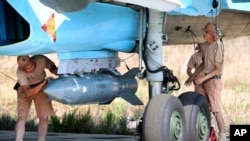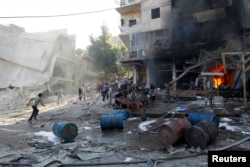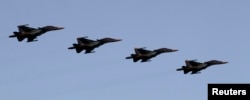For more than a year, Syrian insurgents and civilians in rebellious areas in the war-torn country have been enduring a reign of terror from the skies with President Bashar al-Assad’s aircraft dropping cheaply produced improvised “barrel bombs” on them. Now they’re coming under attack from Russian bombers firing so-called “dumb missiles” designed to maximize casualties.
In video footage released by the Russian Defense Ministry to the media over the past five days of Russian warplanes taking off from the Bassel al-Assad airbase on the Syrian coast for their sorties, a variety of munitions have been spotted by military analysts - but most have been dumb bombs.
The unleashing of unguided ordnance by Russian warplanes was roundly condemned at the weekend by British Defense Minister Michael Fallon. “They are dropping unguided munitions in civilian areas,” he said in an interview with a British newspaper.
“There are clear markings for the OFAB 250-270 unguided bombs on Russian jets in Syria,” said Elliot Higgins, the founder of the Bellingcat blog site, which focuses on weapons use in the Syrian civil war and the conflict in east Ukraine’s Donbas region.
Russia’s air war in Syria so far is similar to the terror that Assad’s air campaign has been sowing from the skies the past few years, say analysts. Cheap improvised devices such as barrels, oil drums and canisters packed with high explosive and metal fragments and fuel began in 2014 to replace purpose-built but aged and imprecise missiles as the Syrian administration ran out of them.
And for the past year the crude-but-deadly barrel bombs have been the Syrian air force’s weapon of choice, prompting widespread international condemnation. They were first used in August 2012 with rudimentary fuses that would detonate on impact, but more recently some have been fitted with altitude-sensitive fuses, which make the bombs explode before they hit the ground, causing even wider damage.
Indiscriminate weapons
As an arbitrary-killing weapon, the high-explosive OFAB 250-270, which weigh 270 kilograms and hurls shrapnel over a wide area, is only a few technological steps above a barrel bomb.
The Soviet-era bomb was designed to destroy military industrial sites, railway junctions and field facilities, and shred personnel in open terrain. It was widely used in Afghanistan and the 2008 war with Georgia.
Military analysts say improvised devices like barrel bombs and high-explosive dumb bombs share a characteristic. They are about symbolism and “the terrorizing of a population,” according to Peter Quentin of the Royal United Services Institute, a British think tank.
On Sunday - as criticism mounted about the use of dumb bombs - a Russian air force spokesman, Col. Igor Klimov, told the Kremlin-run RIA news agency that Russian Su-34 and Su-24 warplanes were also using KH-29L air-to-surface laser-guided missiles in Syria. The KH-29L is the Russian equivalent of the American smart missile the AGM-65 Maverick, which is being used by U.S. warplanes in Syria.
Within hours of Col. Klimov’s statement, state-run Russian media began to flood social media sites with photographs of Russian warplanes fitted with KH-29L missiles attached under their wings.
Precision guided technology doesn’t drive out risk or ensure that bombs and missiles don’t go astray. Accurate on-the-ground or surveillance intelligence is also an essential for targeting, as the weekend U.S. bombing of a hospital in the Afghan town of Kunduz likely demonstrates. But the use of imprecise ordnance increases dramatically the likelihood of civilian and non-combatant casualties because of the indiscriminate nature of the bombing.
Unguided high fragmentation dumb bombs have been more evident in footage broadcast by Russia Today from correspondents based at Bassel al-Assad airbase. “I've mainly seen the planes fitted with unguided munitions; but there have been some rare examples of them using guided munitions,” Higgins, who has been monitoring the channel’s broadcasts, told VOA.
US, others accuse Russia
On Thursday, Lt. Gen. Robert P. Otto, deputy chief of staff in the U.S. Air Force, told reporters that it appeared the Russian forces were relying on “dumb bombs” more than precision weapons guided by lasers or satellites.
Syrian political activists and rebel commanders agree.
“Russia is using just dumb bombs, that’s going to increase the number of civilian casualties,” Hadi Albahra, an anti-Assad opposition leader, tweeted Sunday.
Khaled Khoja, head of the Syrian National Coalition - the Western-backed anti-Assad opposition group - said Russia was "clearly" targeting civilians and opposition-held areas, and called for the enforcement of a no-bombing zone. He accused Moscow of just “enabling Assad’s war on civilians.”
Evidence that dumb munitions are being used more is also coming from analysis of Russian Defense Ministry-supplied video footage of the impact of the airstrikes.
David Cenciotti, a former Italian air force pilot who runs The Aviationist - a military warfare web site - says footage he analyzed of a bombing run Wednesday “shows shrapnel from a bomb possibly exploding south of the target; the second part shows the same target and other shrapnel, but you can also clearly see the blast of a bomb at the bottom of the scene; the third one shows bombs seemingly missing their target by several meters.”
Estimates of casualties from the five days of Russian bombing vary. The pro-opposition monitoring group the Syrian Observatory for Human Rights said Saturday its activists had documented 39 civilian deaths, including eight children and eight women. The group said it had verified the deaths of 14 fighters; a dozen from the Islamic State group in a raid near Raqqa and two from al-Qaida affiliate Jabhat al-Nusra.
Russia bombing raids have hit several provinces since Wednesday with most focused in Idlib in the northwest and Hama in central Syria in territory not controlled by the Islamic State group, the main target of the air campaign, according to the Kremlin.












